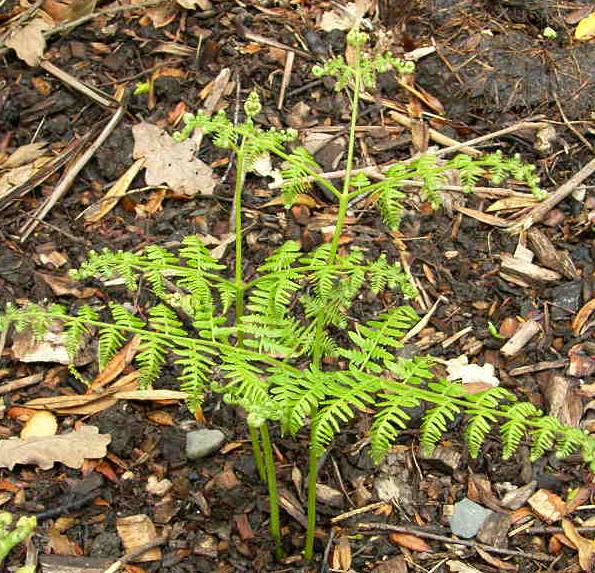BrackenScientific Name : Pteridium aquilinum |
The tall upright leaf stalks of this perennial arise from horizontal rhizomes which can extend over a large area. Effectively the whole of the topgrowth is a leaf and the stout upright part is the leaf stalk, it is bright green at first and becomes brown as the leaf matures through the summer. They can be from 50 to 200 cm tall, depending on the local conditions. The bright green leaflets grow almost horizontally and have many subleaflets diminishing in size towards the tip to form a triangular shape.
In the autumn the whole of the topgrowth dies back to leave a dense covering of brown debris. This, along with some allelopathic chemicals they release, inhibits the growth of other plants in the area. The dry debris is flammable so in dry conditions fires can easily start; this is advantageous to the bracken as it removes competing plants and its deep rhizomes can soon resprout.
The scaly, black rhizomes can be up to 6 metres long with branches and go down to about 3 metres. They have thin, black roots along their length.
There are no flowers, but spores are produced in August and September from spore cases arranged along the underside edges of the leaflets.
As well as the potential allergic properties of the spores, bracken harbours the ticks which pass Lyme disease to humans. The spores have also been implicated as being carcinogenic. The foliage is poisonous to grazing animals which can easily take in the young unfurling fronds - it has been shown to cause bladder and intestinal tumours in such animals. For this reason it would not be welcome in land intended for fodder production.
Despite its toxic nature the young sprouts are eaten as a delicacy in Japan and in parts of North America. It causes a loss of white blood cells and a low platelet count, so should not be eaten in quantity.
Bracken is resistant to many herbicides and recovers from digging due to the extensive underground system. An isolated patch can be removed eventually by continual mowing, which exhausts the rhizomes. Liming the soil can deter it as it prefers acidic conditions. However as it is usually encroaching from hedgerows or adjoining scrubby land it is difficult to remove; a vertical barrier would have to go down very deeply to defeat the rhizomes. If it is possible to keep a clear patch beyond the boundary of the garden it should be kept at bay.
Foraging pigs are very good at dealing with large areas of bracken as they are partial to the shoots and roots. They turn over the ground and leave the land clear of most of the weeds after a few months.
Weedkillers to use:-
Glyphosate has a systemic action taken down into
underground parts, but it would take many applications over a few years to eradicate a well established stand. Application should be as the fronds are opening out to ensure there is active growth and provide a large enough area for absorbtion.
SBK Brushkiller contains selective herbicides.
